|
Since 1796 ... the story of a passion
|
|
1796 : the beginning of a story
|
We are in 1796, in Quintal, small populated village of indomptable Savoyards. Because of outrages committed during the French Revolution, there is neither priest - the priest, refractory, had to leave the Presbytery - or bell, the two church bells had been requisitioned by the revolutionaries to be transformed into guns and coins. The church is closed.
The new mayor, elected in 1795, has only one idea in mind: to reopen the church so that revive the village. He then took his walking stick and went to the bishop which he expresses his concern is also that of its Quintalis.
"You have a priest when you have a bell in your tower! "Replied the prelate, desiring to ensure the seriousness of demande.Il takes more to discourage Savoyard ... Mayor decides to carry the precious bell. For this, it uses a mobile Saintier reputable name Jean-Baptiste Pitton. Once there, the man asks the villagers so that one of them serve his apprenticeship. Privilege of his position or tribute by Quintalis - the story does not say - the Mayor of the town is designated. He is 24 years old and is called Antoine Paccard ...
(photo): October 2010: the seventh and eighth generation of bell founders PACCARD are met in the tower Quintal, which still rings the first bell made in 1796 by Antoine Paccard. It reflects the troubled times in which it was born: "If I survive the Terror, is to sing Happiness."
|
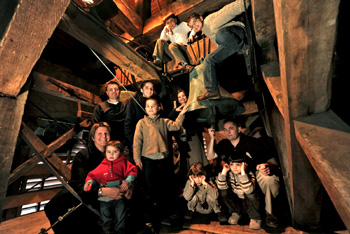 |
|
 |
|
1796-1857: after the revolutionary turmoil
|
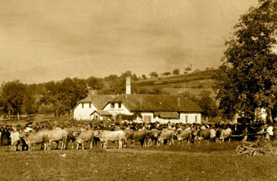 |
With Jean-Baptiste Pitton, Antoine Paccard discovered the craft of bell founder ... and fell in love! He decided to become in turn a founder : then he was far from suspecting that he launched a dynasty of bell founders whose main internationally-recognised name covering all around the world and still endure seven generations later ...
But in 1796, everything is not so simple for Antoine Paccard.Il take him for example waiting for the signing of the Concordat in 1801 for its bell can be hoisted into the tower Quintal. During this turbulent period, Antoine did not hesitate alos to risk his life, hiding in his barn the missionary who came to replace the former priest who was arrested by the revolutionaries.
Precursor, Antoine immediately creates a sedentary foundry, allowing it to improve the quality of its bells. At his death, his son Jean-Pierre and Claude Paccard continue ro run the foundry. Following the extension made by the new industry, they transfer the plant from Quintal to Annecy-le-Vieux, between 1854 and 1857. They were more close from the Annecy train station, first one of the department which was built at the same time, which greatly facilitated the transport of bells and contributed to the development of the company.
|
|
 |
|
1857-1989 : Epic of Annecy-le-Vieux
|
The "Fanfoué"
Jean-Pierre died prematurely, leaving only his widow and three children. To protect his son's ambitions of their uncle Claude Françoise Paccard does not hesitate to "wear the pants" to go to work and run the foundry "like a man." As a sign of respect, we callher: the "Fanfoué" (in dialect, Francis said Fanfoué while Francoise said Fouèse). At majority of his elder son, George, she passes the reins of the company, for never returning back. Fine example of selflessness and maternal devotion ...
George, Francique and Victor Paccard, Jean-Pierre' son , make the company prosper , from the late nineteenth century, acquired an international reputation. George is responsible for the technical direction, and he presides over the casting of more than 10,000 bells. It is to him that we owe the beauty of the shapes of bells PACCARD, the accuracy of their tone, the magnitude of their sound and their harmony. He was in France the main chimes promoter, whose popularity that came from Belgium, has spread throughout the West. In 1891, he runs the largest bell in France: the "Savoy" of the Sacred Heart of Montmarte.
|
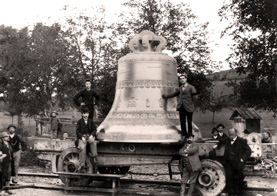 |
|
 |
|
Drones Bell and chimes: control of the profile
|
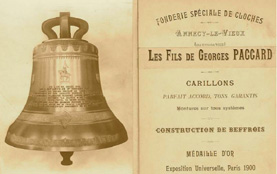 |
Later, Georges Paccard works with his sons, Joseph and Louis, guiding his advice. After the First World War, the foundry produces a large number of bells which some particularly famous as the "Jeanne d'Arc".
Already at that time, 700 to 800 bells out every year workshops for all countries.
Thanks to Alfred Paccard (son of Louis) and his cousins, and Henri Jacques, molding becomes the world specialist chime. Its fame lies in its casting processes, but especially his mastery of tone and note.
In 1950, the Government of the United States make no mistake when ordering 54 replicas of the famous "Liberty Bell" that sounded Independence in 1776.
Since then, the foundry has made many chimes and tones for this country.
|
|
 |
|
The largest swinging bell in the World
|
Thanks to his engineer and his passion for the bells, Alfred develops a specific technique for achieving the chimes, working tirelessly (and sometimes the night in a room holding a workshop more than a place of rest ...) to improve the profile, ensuring good sound. Hundreds of bells will be produced, with, for one purpose, to improve the sound of bells PACCARD, ensuring accuracy and consistency of timbre qualities that a musical instrument is recognized.
Thus born the technical model, which will enable the company to deliver a large number of chimes whose musical quality remains unmatched to this day.
In 1978, following the death of Alfred, his son Pierre took over the management of the company. He signed, among others, two brilliant achievements. In 1986, the largest ring of swinging bells in the World: three bells 6, 10 and 19 tons for Canada. And in 1998, he was entrusted with the implementation of the largest swinging bell in the world in the United States. The surge of 33 tonnes marked the beginning of the third millennium, sounding the stroke of midnight, December 31, 1999 ... engineer like his father, Pierre shared with him his love for his bells. A passion passed on to Philip, who joined the company in 1989, and Cyril, which in turn joins the foundry in 1995.
|
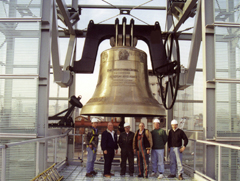 |
|
|